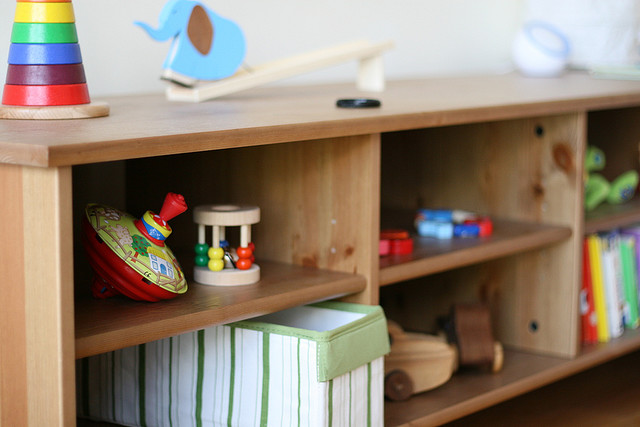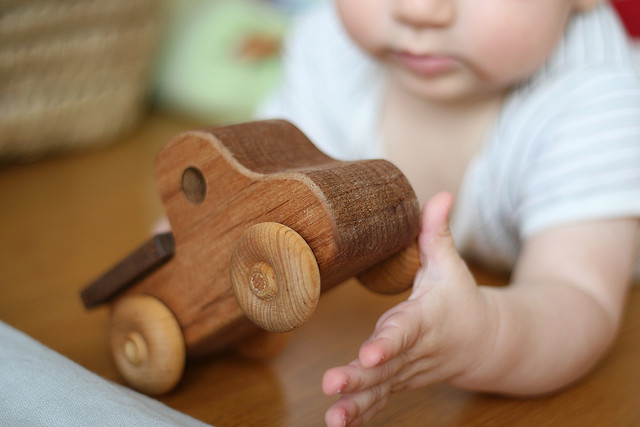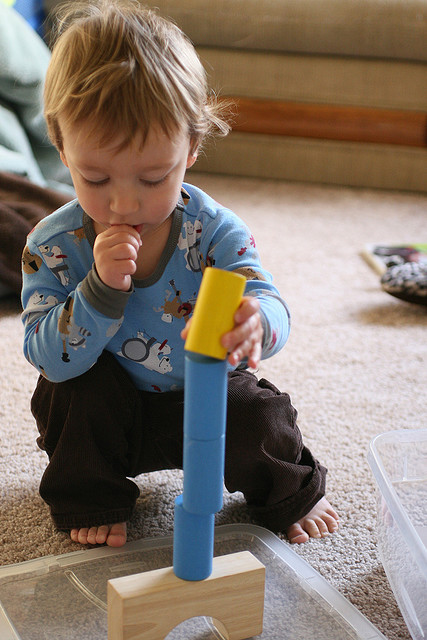


October 30, 2022
I’ve never been a big fan of toy boxes. They seem messy, and as if they’re designed for toys to get lost and/or broken in them. It’s hard to teach children to be careful of their toys when the way to put them away is to toss them into a box with a bunch of other stuff. So when we started thinking about how to set up our son’s room and how to store/display his toys, I knew I didn’t want a toy box.
Instead, I wanted to set up his room as if it were his own private Montessori classroom. This means, rather than toys being hidden away in a toy box somewhere, I wanted to find a low shelf to hold and display his toys so he could easily see them and where each toy would have its own specific place. I spent a good bit of time searching for such a shelf, and we eventually settled on what’s meant as an entertainment center from Ikea. It’s low to the ground making it easy for him to take them off the shelf and put them back independently. The fact that he can see the toys neatly arranged on the shelf makes them more inviting (they don’t get “forgotten” at the bottom of a box), and the fact that they each have a specific place encourages him to put them back in that spot when he’s done playing.
Now, once you have the shelf, what to fill it with?
It’s difficult, if not impossible, to control what others give you as gifts. But, when we’ve spent our own money on toys, I’ve been very careful about what we buy. The most popular children’s toys today are inexpensive plastic objects that light up and make all sorts of noise. They are cheap to buy, but often require frequent replacement when they get broken… or are recalled for having been poorly made. Both my husband and I have a strong aversion to toys that make noise, so we’ve avoided those like the plague (and I would argue it’s made us saner parents, not having to listen to the same slice of a song or sentence repeated by a toy over and over!).
Most of the toys I’ve bought are made of wood. Wooden toys tend to be better made and last longer (and are, in my opinion, much more pleasing to the eye). Most of his toys also encourage open-ended play, meaning he gets to decide what to do with them. Many children’s toys are designed for a specific purpose, to be played with in one specific way. Some simply require the child to sit there and press a button while the toy does all the work. I’d rather buy toys that encourage my child to be creative, to use his imagination, and to decide how to use them. Wooden blocks, for example, are perfect for this. My favorite places to shop for wooden toys are Oompa.com, Michael Olaf’s catalog, and Ikea (who has a surprisingly lovely collection of wooden toys for kids…who knew?).
I’ve often heard parents lament that they would love to buy wooden toys, but they’re too just too expensive. Who can afford to buy all those beautiful, wooden toys?
My answer is that quality matters much more than quantity. Children don’t need a mass of toys. That’s part of the beauty of using a shelf over a toy box– a shelf holds only so much space, so it naturally limits the number of toys you can have out at any one time (I keep his other toys in plastic bins stashed in other parts of the house, and try to rotate the toys on the shelf about every 1-2 weeks). Have you ever been at a store and needed to buy, say, face lotion or contact solution, and you stare at the wall full of options and freeze, unable to make a decision? I really believe kids experience the same thing with toys. Having options is good, but having too many options can be debilitating. If they have a multitude of toys in front of them, they don’t really know what to do. They might start playing with one, then get distracted by another, and will only play superficially with a series of toys without ever really sitting down with one and getting lost in play with it. This means they don’t get the opportunity to develop focus and concentration by playing deeply with one toy for an extended period of time.
I know I’ve noticed a difference in the quality of play in my toddler when I keep the number of available toys low versus the days when I try to buy myself “extra time” by bringing out more toys. If he only has a few toys out, he’ll choose one or two and play with them for much longer periods of time. When I bring out a boxful of toys, he’ll get excited about all those toys to play with… but then quickly tires of them and looks for something else to do.
Also, don’t forget that you don’t have to spend lots of money for good quality, simple toys– bowls, wooden spoons, and measuring cups from your kitchen can be incredibly entertaining for an older infant or toddler. Or, go outside and find some sticks, dirt, and rocks. It can be surprisingly simple and cheap to find fascinating “toys” for little hands and minds to explore.
By the way, the added benefit of limiting the number of toys you have out? Much more manageable housekeeping. Picking up 10 toys off the floor is much easier for you and your child to clean up after than picking up 20 or more! So bottom line, less is more– both for you and your child! ; )